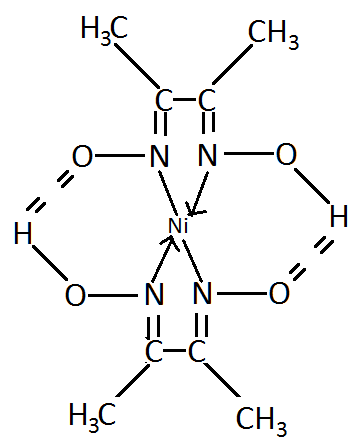
What is the coordination number of Ni in the nickel-DMG complex?
A.\[2\]
B.$3$
C.$6$
D.$4$
Answer
467.7k+ views
Hint: The directly bonded atoms, molecules or ions to the central metal atom of a complex are known as co – ordination compounds. The total number of co – ordination compounds is known as co – ordination number.
Complete step by step answer:
The number of atoms, ions or molecules directly bonded with the central metal atom in a complex is known as its co – ordination number. The steps involved to find the co - ordination number are as follows:
First of all we have to identify the central metal atom in the chemical structure or chemical formula.
Now count the total number of ions, atoms or molecules directly bonded with the central metal atom.
So in this way we can find out the co – ordination number.
DMG, also known as dimethylglyoxime is a chemical compound which is mostly used as ligands in the co – ordination compounds. The chemical formula for dimethylglyoxime is \[{\text{C}}{{\text{H}}_{\text{3}}}{\text{C}}\left( {{\text{NOH}}} \right){\text{C}}\left( {{\text{NOH}}} \right){\text{C}}{{\text{H}}_{\text{3}}}\] .
The chemical structure of nickel – DMG is as follows:

Here in this structure we can see that the central nickel atom is directly attached with the four atoms. And all these four atoms are nitrogen, and we discussed above that the atoms, ions or molecules directly attached to the central atom are included in co – ordination number, therefore the co – ordination number of nickel atom in nickel dimethylglyoxime is four.
Hence option (D) is correct, 4.
Note: The ions or molecules which are neutral and attached to the central metal atom or ion of a complex are known as ligands. The ligands act as lewis base or electron pair donors and the central atom acts as lewis acid or electron pair acceptor.
Complete step by step answer:
The number of atoms, ions or molecules directly bonded with the central metal atom in a complex is known as its co – ordination number. The steps involved to find the co - ordination number are as follows:
First of all we have to identify the central metal atom in the chemical structure or chemical formula.
Now count the total number of ions, atoms or molecules directly bonded with the central metal atom.
So in this way we can find out the co – ordination number.
DMG, also known as dimethylglyoxime is a chemical compound which is mostly used as ligands in the co – ordination compounds. The chemical formula for dimethylglyoxime is \[{\text{C}}{{\text{H}}_{\text{3}}}{\text{C}}\left( {{\text{NOH}}} \right){\text{C}}\left( {{\text{NOH}}} \right){\text{C}}{{\text{H}}_{\text{3}}}\] .
The chemical structure of nickel – DMG is as follows:

Here in this structure we can see that the central nickel atom is directly attached with the four atoms. And all these four atoms are nitrogen, and we discussed above that the atoms, ions or molecules directly attached to the central atom are included in co – ordination number, therefore the co – ordination number of nickel atom in nickel dimethylglyoxime is four.
Hence option (D) is correct, 4.
Note: The ions or molecules which are neutral and attached to the central metal atom or ion of a complex are known as ligands. The ligands act as lewis base or electron pair donors and the central atom acts as lewis acid or electron pair acceptor.
Recently Updated Pages
Master Class 12 English: Engaging Questions & Answers for Success

Master Class 12 Business Studies: Engaging Questions & Answers for Success

Master Class 12 Social Science: Engaging Questions & Answers for Success

Master Class 12 Chemistry: Engaging Questions & Answers for Success

Class 12 Question and Answer - Your Ultimate Solutions Guide

Master Class 12 Economics: Engaging Questions & Answers for Success

Trending doubts
Which are the Top 10 Largest Countries of the World?

Differentiate between homogeneous and heterogeneous class 12 chemistry CBSE

What is a transformer Explain the principle construction class 12 physics CBSE

Draw a labelled sketch of the human eye class 12 physics CBSE

What are the major means of transport Explain each class 12 social science CBSE

What is the Full Form of PVC, PET, HDPE, LDPE, PP and PS ?




